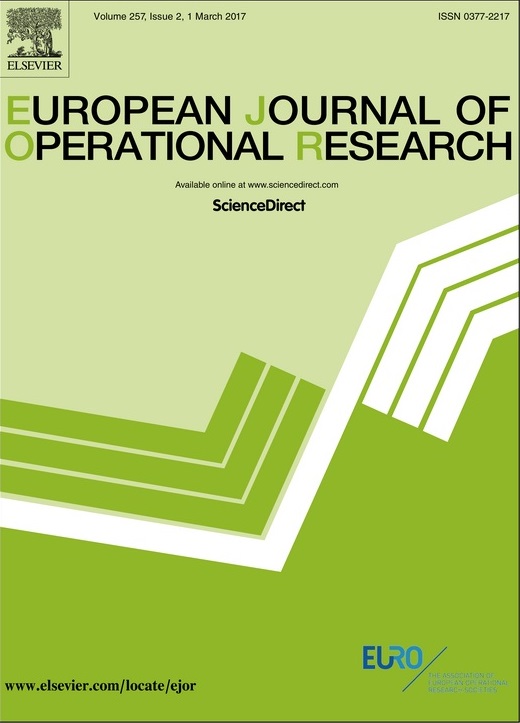EURO Excellence in Practice Award 2025 - Finalists
The three finalists of the 2025 EURO Excellence in Practice Award are:
Katrin Heßler, Timo Hintsch, Lukas Wienkamp Schenker AG
BinPACKER
One of the biggest challenges in transportation is to load a transport unit, such as a container, a truck, or a pallet, in a way that minimizes empty space and thus reduces costs. Manual planning is difficult and requires a lot of time. BinPACKER automizes this task subject to several practical constraints, such as load stability, consideration of non-stackable items, and weight distribution requirements. This not only leads to a significant reduction of empty space and transport costs but also considerably reduces manual planning effort.
Toni Wickert, Alberto Kummer, Fabricio Nunes Da Costa, Henrique Lima Baiao, Leila Yasmin Abdala, Mateus De Paula Nascimento, Jackson De Sousa Marques Magalhaes, Ricardo Mauricio Solar Vivanco, Cid Carvalho de Souza Shipping Optimization Team (SOT), Mercado Livre
Logistics Performance Excellence: Optimizing the Dedicated Fleet of Mercado Livre
In Latin America, road transport is by far the primary mode of transportation for transferring goods between different locations. Trucks are contracted from transportation companies mainly in two forms: full truckload (FTL) or dedicated fleet, each of which has its own advantages and disadvantages, depending on the existing operational restrictions. At Mercado Livre, the largest e-commerce company in the region, we face the challenge of finding the right balance between FTL and dedicated fleet trucks to minimize operational costs. This work presents a novel approach for composing a dedicated fleet of trucks used in Mercado Livre to tackle this prevalent challenge in the retail industry. We propose a mixed-integer programming method based on a heuristic algorithm that generates optimized itineraries for a fleet of vehicles organized into groups, considering both hiring and operational constraints. Each of these groups is assigned to different carriers, thereby avoiding reliance on a single provider. The tool was used in 2024 across the Brazilian and Mexican operations of Mercado Livre and generated savings exceeding US$ 10 million, along with improved service levels characterized by reduced delays and enhanced truck availability during peak seasons. Additionally, by contracting dedicated trucks, we can now operate 116 vehicles powered by natural gas or biomethane, thereby diminishing Mercado Livre's environmental impact.
Serena Fugaro National Research Council of Italy, Antonino Sgalambro Leeds University Business School, Filippo Santarelli National Research Council of Italy
A Spatial Decision Support System for designing the network of Household Waste Recycling Centres in South Yorkshire
In the UK Government's 25 Year Environment Plan, the location of municipal waste collection and recycling facilities plays a crucial role in achieving the recycling targets. Locally, these services are provided to residents through Household Waste Recycling Centres (HWRCs). The UK Government recognises the need to plan the network of HWRCs carefully to ensure their efficient operation and appropriate use by residents. Local authorities are interested in reorganising HWRC networks with the dual aim of reducing operating costs and achieving high levels of user satisfaction, whilst meeting specific legislative requirements.
In this project, in collaboration with the Sheffield City Council in South Yorkshire (UK), we have developed a tailored spatial Decision Support System (DSS) for the optimal reconfiguration of HWRC networks. The model base component of the DSS builds upon a novel Multi-Objective Covering-Location-Allocation problem that formalises the underlying real-world Waste Management scenario taking into account multiple goals and different stakeholders (i.e. local authorities and service users). A soft-constrained solution approach is developed to accurately capture the actual dynamics driving the network design process, and to explore the impact of facility capacity flexibility.
The resulting Pareto sets are efficiently explored using a robust variant of the AUGMEnted ε-CONstraint method, and a computational characterisation of the proposed models is provided with benchmark instances from the real-world case study.
The DSS is framed in the open source QGIS software through the design and implementation of an ad hoc plug-in that allows for an effective management of the DSS database component and a user-friendly graphical representation and comparison of Pareto Optimal solutions. The Graphical User Interface of the DSS has been co-designed with the local authorities to facilitate an intuitive visualisation of the characteristics of the alternative configurations generated by the model, and to enhance the usability of the tool by allowing the exploration of the trade-offs between objectives.
A thorough scenario and sensitivity analysis demonstrates how the DSS is successful in producing alternative configurations for the HWRC network design problem and providing quantitative and qualitative insights to support strategic planning and decision-making.

This work is licensed under a Creative Commons Attribution-ShareAlike 3.0 International License and the GNU Free Documentation License (unversioned, with no invariant sections, front-cover texts, or back-cover texts).




